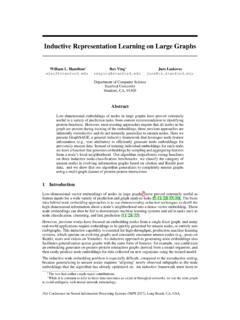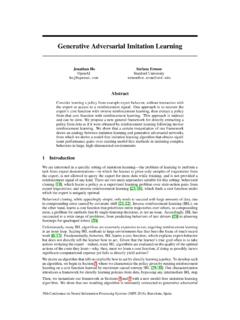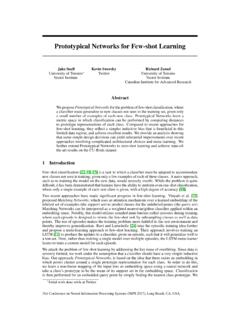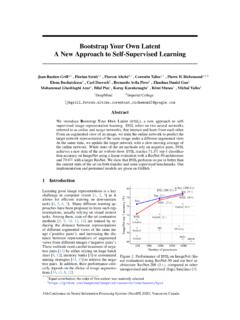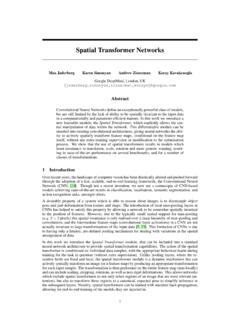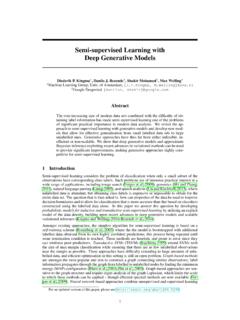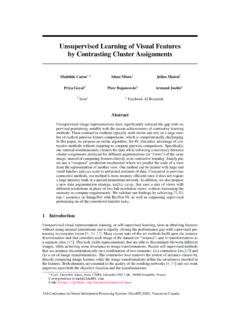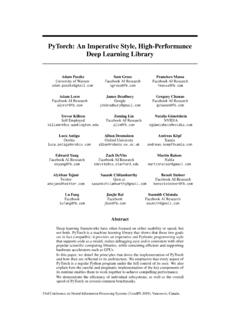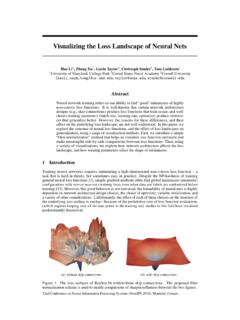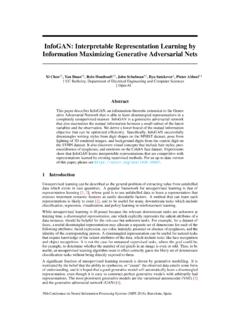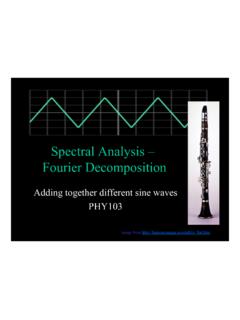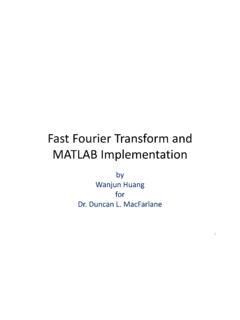Transcription of Convolutional Neural Networks on Graphs with Fast ...
1 Convolutional Neural Networks on Graphswith Fast Localized spectral FilteringMicha l DefferrardXavier BressonPierre VandergheynstEPFL, Lausanne, this work, we are interested in generalizing Convolutional Neural Networks (CNNs) from low-dimensional regular grids, where image, video and speech arerepresented, to high-dimensional irregular domains, such as social Networks , brainconnectomes or words embedding, represented by Graphs . We present a formu-lation of CNNs in the context of spectral graph theory, which provides the nec-essary mathematical background and efficient numerical schemes to design fastlocalized Convolutional filters on Graphs .
2 Importantly, the proposed technique of-fers the same linear computational complexity and constant learning complexityas classical CNNs, while being universal to any graph structure. Experiments onMNIST and 20 NEWS demonstrate the ability of this novel deep learning systemto learn local, stationary, and compositional features on IntroductionConvolutional Neural Networks [19] offer an efficient architecture to extract highly meaningful sta-tistical patterns in large-scale and high-dimensional datasets. The ability of CNNs to learn localstationary structures and compose them to form multi-scale hierarchical patterns has led to break-throughs in image, video, and sound recognition tasks [18].
3 Precisely, CNNs extract the local sta-tionarity property of the input data or signals by revealing local features that are shared acrossthe data domain. These similar features are identified with localized Convolutional filters or kernels,which are learned from the data. Convolutional filters are shift- or translation-invariant filters, mean-ing they are able to recognize identical features independently of their spatial locations. Localizedkernels or compactly supported filters refer to filters that extract local features independently of theinput data size, with a support size that can be much smaller than the input data on social Networks , gene data on biological regulatory Networks , log data on telecommu-nication Networks , or text documents on word embeddings are important examples of data lying onirregular or non-Euclidean domains that can be structured with Graphs , which are universal represen-tations of heterogeneous pairwise relationships.
4 Graphs can encode complex geometric structuresand can be studied with strong mathematical tools such as spectral graph theory [6].A generalization of CNNs to Graphs is not straightforward as the convolution and pooling operatorsare only defined for regular grids. This makes this extension challenging, both theoretically andimplementation-wise. The major bottleneck of generalizing CNNs to Graphs , and one of the primarygoals of this work, is the definition of localized graph filters which are efficient to evaluate and , the main contributions of this work are summarized spectral graph theoretical formulation of CNNs on Graphs builton established tools in graph signal processing (GSP).
5 [31]. localized [4], the proposed spectral filters are provable to bestrictly localized in a ball of radiusK, from the central computational evaluation complexity of our filters is linear thefilters support s sizeKand the number of edges|E|. Importantly, as most real-world graphsare highly sparse, we have|E| n2and|E|=knfor the widespreadk-nearest neighbor30th Conference on Neural Information Processing Systems (NIPS 2016), Barcelona, connected layersFeature extractionConvolutional layersInput graph bags of wordsOutput labelsGraph signal filtering1. Convolution2. Non-linear activationGraph coarsening3.
6 Sub-sampling4. PoolingFigure 1: Architecture of a CNN on Graphs and the four ingredients of a (graph) Convolutional layer.(NN) Graphs , leading to a linear complexity the input data sizen. Moreover, thismethod avoids the fourier basis altogether, thus the expensive eigenvalue decomposition(EVD) necessary to compute it as well as the need to store the basis, a matrix of is especially relevant when working with limited GPU memory. Besides the data, ourmethod only requires to store the Laplacian, a sparse matrix of|E|non-zero propose an efficient pooling strategy on Graphs which, after a rear-rangement of the vertices as a binary tree structure, is analog to pooling of 1D present multiple experiments that ultimately show that our for-mulation is (i) a useful model, (ii) computationally efficient and (iii) superior both in accu-racy and complexity to the pioneer spectral graph CNN introduced in [4].
7 We also showthat our graph formulation performs similarly to a classical CNNs on MNIST and study theimpact of various graph constructions on performance. The TensorFlow [1] code to repro-duce our results and apply the model to other data is available as an open-source Proposed TechniqueGeneralizing CNNs to Graphs requires three fundamental steps: (i) the design of localized convolu-tional filters on Graphs , (ii) a graph coarsening procedure that groups together similar vertices and(iii) a graph pooling operation that trades spatial resolution for higher filter Learning Fast Localized spectral FiltersThere are two strategies to define Convolutional filters; either from a spatial approach or from aspectral approach.
8 By construction, spatial approaches provide filter localization via the finite sizeof the kernel. However, although graph convolution in the spatial domain is conceivable, it facesthe challenge of matching local neighborhoods, as pointed out in [4]. Consequently, there is nounique mathematical definition of translation on Graphs from a spatial perspective. On the otherside, a spectral approach provides a well-defined localization operator on Graphs via convolutionswith a Kronecker delta implemented in the spectral domain [31]. The convolution theorem [22]defines convolutions as linear operators that diagonalize in the fourier basis (represented by theeigenvectors of the Laplacian operator).
9 However, a filter defined in the spectral domain is notnaturally localized and translations are costly due to theO(n2)multiplication with the graph Fourierbasis. Both limitations can however be overcome with a special choice of filter fourier are interested in processing signals defined on undirected andconnected graphsG= (V,E,W), whereVis a finite set of|V|=nvertices,Eis a set of edges andW Rn nis a weighted adjacency matrix encoding the connection weight between two signalx:V Rdefined on the nodes of the graph may be regarded as a vectorx Rnwherexiis the value ofxat theithnode.
10 An essential operator in spectral graph analysis is thegraph Laplacian [6], which combinatorial definition isL=D W Rn nwhereD Rn nis the1 degree matrix withDii= jWij, and normalized definition isL=In D 1/2WD 1/2whereInis the identity matrix. AsLis a real symmetric positive semidefinite matrix, it has acomplete set of orthonormal eigenvectors{ul}n 1l=0 Rn, known as the graph fourier modes, andtheir associated ordered real nonnegative eigenvalues{ l}n 1l=0, identified as the frequencies of thegraph. The Laplacian is indeed diagonalized by the fourier basisU= [u0,..,un 1] Rn nsuch thatL=U UTwhere = diag([ 0.)]
